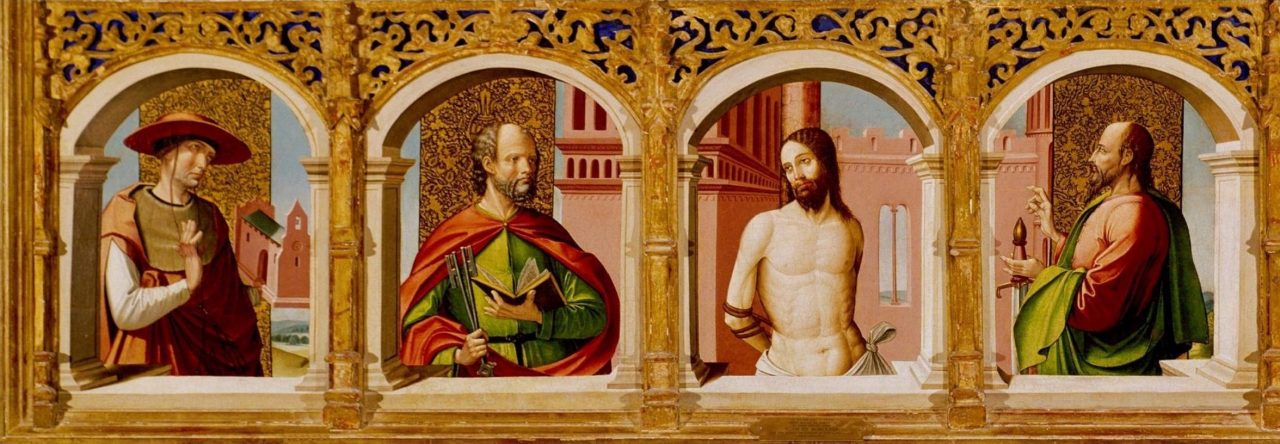 The San Luigi Orders comprise three interrelated entities; the Orders of the Crown of Thorns, and of the Lion and the Black Cross; together with the Grand Prix Humanitaire de France et des Colonies which is the Cross of Merit of the Order of the Crown of Thorns.
The San Luigi Orders comprise three interrelated entities; the Orders of the Crown of Thorns, and of the Lion and the Black Cross; together with the Grand Prix Humanitaire de France et des Colonies which is the Cross of Merit of the Order of the Crown of Thorns.
The Orders of the Crown of Thorns and of the Lion and the Black Cross are Orders of Chivalry according to the historic definition of that term. The Order of the Crown of Thorns was founded by St. Louis IX, King of France, on 10 August 1239, and remained united with the French crown until the fall of the French monarchy. In the late nineteenth-century, two separate revivals of the Order took place, which were united into a single body in 1899. The Order of the Lion and the Black Cross was founded by the first Prince-Abbot of San Luigi on 15 October 1883, during his period of effective sovereignty in the Fezzan.
From 1960 onwards each order was placed under a High Protector. In the case of the Order of the Crown of Thorns, this was the late King Peter II of Yugoslavia and since his death in 1970 this position has been left vacant in his memory. The Order of the Lion and the Black Cross appointed as its High Protector the Crown Prince of Japan, now H.I.M. Emperor Emeritus Akihito.
Since 2012, H.M. the Omukama of Bunyoro-Kitara has been Royal Patron and Royal Protector of the Order of the Crown of Thorns and the Order of the Lion and the Black Cross. His Majesty, exercising his powers as a sovereign fons honorum, granted the two San Luigi Orders new Royal Charters, whereupon they were placed under the Royal Protection of a reigning monarch whose kingdom extends to some 1.4 million souls.
H.S.H. the Most Revd. Prince Kermit de Polanie-Patrikios also served as a Royal Patron of the San Luigi Orders until his death in 2015.
In addition, the Prince-Abbot of San Luigi is responsible for the protection of several other Orders which are listed below, and in his capacity of Head of the Royal House Polanie-Patrikios is Prince Grand Master of the dynastic orders of that House, known as the Royal Byelorussian Orders.
The High Protectorate
High Protector of the Order of the Crown of Thorns
The late H.M. King Peter II of Yugoslavia
>>King Peter II and the Abbey-Principality of San Luigi
High Protector of the Order of the Lion and the Black Cross
H.I.M. Emperor Emeritus Akihito of Japan
High Protector of the Order of Antioch
The late H.I.R.H. Prince Louis Ferdinand of Prussia
The Royal Patron and Protector
Royal Patron and Protector of the Orders of the Crown of Thorns and of the Lion and the Black Cross
H.M. Rukirabasaija Agutamba Solomon Gafabusa Iguru I
49th Omukama of the Kingdom of Bunyoro-Kitara
>>Profile and further information
The Prince Grand Master
Prince Grand Master of the San Luigi Orders
H.S.H. Edmond III
8th Prince-Abbot and 6th Mukungu of San Luigi
>>Profile and further information
Membership
Membership of the San Luigi Orders is conferred by the Prince Grand Master on individuals of demonstrated merit after an invitation or following nomination from an existing member. For further information concerning membership, please see this page.
The San Luigi Orders
(1) The Sovereign, Chivalrous, Noble and Religious Order of the Crown of Thorns (L’Ordre Souverain, Chevaleresque, Nobilaire et Religieux de la Couronne d’Epines)
 A full history of this Order, which is a revival of an earlier mediaeval entity, is given on a separate page:
A full history of this Order, which is a revival of an earlier mediaeval entity, is given on a separate page:
>>Full history of the Order of the Crown of Thorns
The Order of the Crown of Thorns was founded by St. Louis IX, King of France, on 10 August 1239. It fell into disuse for some centuries, but remained officially united with the French crown until the fall of the French monarchy. In the late nineteenth-century, two separate revivals of the Order took place, which were united into a single body in 1899.
In the modern era, the Order was re-established on 1 June 1891 on the authority of the Syrian Orthodox Patriarch, His Beatitude Ignatius Peter III/IV. In 1892, the 1922 History relates, “Patriarch Ignatius Peter III, the successor of St Peter, sent for Mar Timotheus I, who had been consecrated metropolitan archbishop for work amongst the Orthodox Catholics in America by Julius I, Archbishop of the Syrian Church in Ceylon, in accordance with the Bulls issued by the Patriarch, and conferred upon him the Grand Mastership of the Order of the Crown of Thorns, and intrusted to him the regulations of the Order.”
Meanwhile, a separate Order of the Crown of Thorns had been founded together with the Order of the Lion and the Black Cross by Prince-Abbot Henrice of San Luigi on 15 October 1883, during San Luigi’s period of territorial sovereignty. By decision of Prince-Abbot Joseph III, who was consecrated by the Syrian Orthodox Church and therefore accorded primacy to the 1891 Order under the authority of the Patriarch, this branch was absorbed into the 1891 Order when both came under the same headship in 1899.
 The Order has as its aims (1) to defend the Christian Ideology, Tradition and Cultural Inheritance; (2) to preserve the best ideals of Knighthood of past centuries and the noble spiritual virtues of the Knights Templar; and (3) to help forward any charitable works under the Patronage of the Order. The Order also has the aim of rewarding persons who have distinguished themselves in defence of the Church, of humanity, or in philanthropic work initiated by the Order and have shown a Christian spirit, a clean life and a noble example. Membership of the Order is confined to baptised Christians who accept the Nicene Creed in its natural interpretation.
The Order has as its aims (1) to defend the Christian Ideology, Tradition and Cultural Inheritance; (2) to preserve the best ideals of Knighthood of past centuries and the noble spiritual virtues of the Knights Templar; and (3) to help forward any charitable works under the Patronage of the Order. The Order also has the aim of rewarding persons who have distinguished themselves in defence of the Church, of humanity, or in philanthropic work initiated by the Order and have shown a Christian spirit, a clean life and a noble example. Membership of the Order is confined to baptised Christians who accept the Nicene Creed in its natural interpretation.
The Royal Charter of the Order graciously granted by His Majesty the Omukama of Bunyoro-Kitara in 2012 can be read here.
The Statutes of the Order, which give full details of its protocols for membership and related activities, can be read here.
The historic Statutes of the Order issued under Prince-Abbot Joseph III in 1900, 1922 and the additions effective in 1938 are all in the possession of the Abbey-Principality, and can be read on the historic documents page.
 (2) The Sovereign, Knightly and Noble Order of the Lion and the Black Cross (L’Ordre Souverain, Chevaleresque et Noble du Lion et de la Croix Noire), also known as the Order of the Lion and the Black Star.
(2) The Sovereign, Knightly and Noble Order of the Lion and the Black Cross (L’Ordre Souverain, Chevaleresque et Noble du Lion et de la Croix Noire), also known as the Order of the Lion and the Black Star.
This Order of Chivalry was founded by the first Prince-Abbot of San Luigi, Revd. Fr. Dom Henrice Pacomez, on 15 October 1883. The symbolic Lion represented is the Lion of Judah, which overcomes the Cross in its act of salvation.
It has as its aims (1) to unite together those who accept the ancient standards of Chivalry; (2) to help forward any charitable works under the Patronage of the Order; (3) to reward those who have distinguished themselves in the service of mankind or of the San Luigi Orders, without distinction as to race or creed. It is thus open both to Christians and to non-Christians.
The Royal Charter of the Order graciously granted by His Majesty the Omukama of Bunyoro-Kitara in 2012 can be read here.
 The Statutes of the Order, which give full details of its protocols for membership and related activities, can be read here.
The Statutes of the Order, which give full details of its protocols for membership and related activities, can be read here.
The original Statutes of the Order, published in 1899 under Prince-Abbot Joseph III, and their revision in 1934-35 are in the possession of the Abbey-Principality and can be read on the historic documents page.
(3) Le Grand Prix Humanitaire de France et des Colonies
 This award was established on 18 September 1892 by M. Charles Leroy and subsequently became attached to the San Luigi Orders in 1899 as part of the transfer of Prince-Abbot Louis-François, when it was designated as the Cross of Merit of the Order of the Crown of Thorns, this being confirmed in the succession document in favour of Prince-Abbot Edmond I of 1923. A description is given in the statutes of that Order from the 1930s, and in the 1953 history of the Orders. This award was originally intended to honour those who had strived in the service of saving human life “to save their fellow rescuers and particularly at sea.” Subsequently, its scope was expanded to an award limited to a maximum of ten per year and usually four or less. The Grand Prix was formerly under the Patronage of the late Sawai Man Singh II, the last Maharajah of Jaipur.
This award was established on 18 September 1892 by M. Charles Leroy and subsequently became attached to the San Luigi Orders in 1899 as part of the transfer of Prince-Abbot Louis-François, when it was designated as the Cross of Merit of the Order of the Crown of Thorns, this being confirmed in the succession document in favour of Prince-Abbot Edmond I of 1923. A description is given in the statutes of that Order from the 1930s, and in the 1953 history of the Orders. This award was originally intended to honour those who had strived in the service of saving human life “to save their fellow rescuers and particularly at sea.” Subsequently, its scope was expanded to an award limited to a maximum of ten per year and usually four or less. The Grand Prix was formerly under the Patronage of the late Sawai Man Singh II, the last Maharajah of Jaipur.
 With its attachment to the San Luigi Orders in 1899, the Grand Prix Humanitaire de France et des Colonies acquired an international character and ceased to be purely a French award. Although it preserves its original title, today the present-day Grand Prix has no organizational connection with the French Republic or its former colonies, and is a purely commemorative and chivalric award.
With its attachment to the San Luigi Orders in 1899, the Grand Prix Humanitaire de France et des Colonies acquired an international character and ceased to be purely a French award. Although it preserves its original title, today the present-day Grand Prix has no organizational connection with the French Republic or its former colonies, and is a purely commemorative and chivalric award.
This award is conferred rarely and with an annual limit on the number of recipients. Nominations of deserving candidates may be made to the Prince-Abbot by existing members of the San Luigi Orders.
The Statutes of the Grand Prix can be read here.


You must be logged in to post a comment.